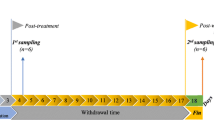Abstract
Concerns regarding the presence of drug residues in foods include allergic reactions, toxicity, technological problems in fermented products and the development of antibiotic resistance in human pathogens. The analysis of antimicrobial residues in foods is generally carried out, in a first step, through microbiological screening tests. These tests commonly use Geobacillus stearothermophilus as target specie but show a low ability to detect quinolones. The goal of our study was to evaluate the performance of a new microbiological test (Equinox) for detection of quinolone residues in muscle. The kit contains an ampoule with a standardized number of freeze-dried Escherichia coli and must be diluted with a specific detection medium containing a redox indicator. Microbial growth will modify the redox potential of the medium being observed through a colour change (from blue to brown/orange). Equinox limits of detection for most of tested quinolones (enrofloxacin, norfloxacin, sarafloxacin, marbofloxacin, ciprofloxacin, danofloxacin and difloxacin) were below or around maximum residue limit (MRL) UE and CCβ values obtained corresponded with the determined sensitivities. In contrast, flumequine could not be detected at MRL UE levels. Moreover, Equinox displayed a low sensitivity to other antimicrobials. Sensitivity data obtained in vitro were consistent when testing incurred muscle samples. Matrix constituents, test batch and animal species did not affect the performance of the test. Equinox could be easily automated enabling a large numbers of simultaneous analysis, and a photometric reading can be applied for a precise interpretation. The results obtained in this study prove that Equinox is a useful tool when screening for quinolone residues or can be combined with other methods for screening of unknown samples.


Similar content being viewed by others
References
Anonymous (1990) Council Regulation (EC) No 2377/90. Official Journal of the European Communities L224/1
Anonymous (2000) Commission Decision 2002/657/EC. Official Journal of the European Communities L221:8–36
Calderón V, González J, Díez P, Berenguer JA (1996) Food Addit Contam 13:13
Cantwell H, O'keeffe M (2006) Food Addit Contam 23:2
Cerny A (1996) Schweiz Med Wochenschr 126:528
Cullor JS (1992) Vet Med 87:1235
Currie D, Lynas L, Kennedy G, McCaughey J (1998) Food Addit Contam 15:651
Demoly P, Romano A (2005) Curr Allergy Asthma Rep 1:9
EMEA (1999) EMEA/CVMP/342/99-Final, London
Fàbrega A, Sánchez-Céspedes J, Soto S, Vila J (2008) Int J Antimicrob Agents 31:4
Fuselier R, Cadieu N, Maris P (2000) EuroResidue IV
Gaudin V, Maris P, Fuselier R, Ribouchon JL, Cadieu N, Rault A (2004) Food Addit Contam 21:5
Gaudin V, Hedou C, Verdon E (2009) Food Addit Contam Part A 26:8
Hawkey PM (2003) J Antimicrob Chemother 51:29
Hernández-Arteseros A, Compañó R, Prat MD (1998) Analyst 123:2729
Hooper DC, Wolfson JS (1993) 1993. In: Hooper DC, Wolfson JS (eds) Quinolone antimicrobial agents, vol. 53, 2nd edn. American Society for Microbiology, Washington DC
Hoshino K, Kitamura A, Morrissey I, Sato K, Kato J, Ikeda H (1994) Antimicrob Agents Chemother 38:11
Levy SB (1998) Sci Am 278:46
Mäyra-Mäkinen A (1995) IDF Bull. Special Issue 9505. 136–143
Moats WA, Romanowski RD (1998) J Chromatogr A. 812:237–247
Myllyniemi AL, Rannikko R, Lindfors E, Niemi A, Bäckman C (2000) Food Addit Contam 17:12
Myllyniemi AL, Nuotio L, Lindfors E, Rannikko R, Niemi A, Bäckman C (2001) Analyst 126:5
Okerman L, De Wasch K, Van Hoof J (1998) Analyst 123:11
Okerman L, Noppe H, Cornet V, De Zutter L (2007) Food Addit Contam 24:3
Pikkemaat MG, Mulder PPJ, Elferink JWA, De Cocq A, Nielen MWF, Van Egmond HJ (2007) Food Add Contam 24:8
Rose MD, Bygrave J, Stubbings GW (1998) Analyst 123:12
Roybal JE, Pfenning AP, Turnipseed SB, Walker CC (2002) J AOAC Int 85:6
Scortichini G, Annunziata L, Di Girolamo V, Buratti R, Galarini R (2009) Anal Chim Acta 637:1–2
Stead S, Sharman M, Tarbin JA, Gibson E, Richmond S, Stark J, Geijp E (2004) Food Addit Contam Part A 21:3
Suhren G, Heeschen W (1996) Nahrung 40:1
Tittlemier SA, Gélinas JM, Dufresne G, Haria M, Querry J, Cleroux C, Ménard C, Delahaut P, Singh G, Fischer-Durand N, Godefroy SB (2008) Food Anal Methods 1:1
WHO (2001) Antibiotic resistance: synthesis of recommendations by expert policy groups. Alliance for the Prudent use of antibiotics. World Health Organization, Geneva, Switzerland. http://whqlibdoc.who.int/hq/2001/WHO_CDS_CSR_DRS_2001.10.pdf
Acknowledgements
Incurred ovine tissue samples used in this study were obtained with the financial support of Ministerio de Ciencia y Tecnología (INIA CAL03-044-C5). The authors thank Benito Herraiz for his excellent technical assistance.
Author information
Authors and Affiliations
Corresponding author
Rights and permissions
About this article
Cite this article
Sanz, D., Mata, L., Condón, S. et al. Performance of a New Microbial Test for Quinolone Residues in Muscle. Food Anal. Methods 4, 212–220 (2011). https://doi.org/10.1007/s12161-010-9151-7
Received:
Accepted:
Published:
Issue Date:
DOI: https://doi.org/10.1007/s12161-010-9151-7




